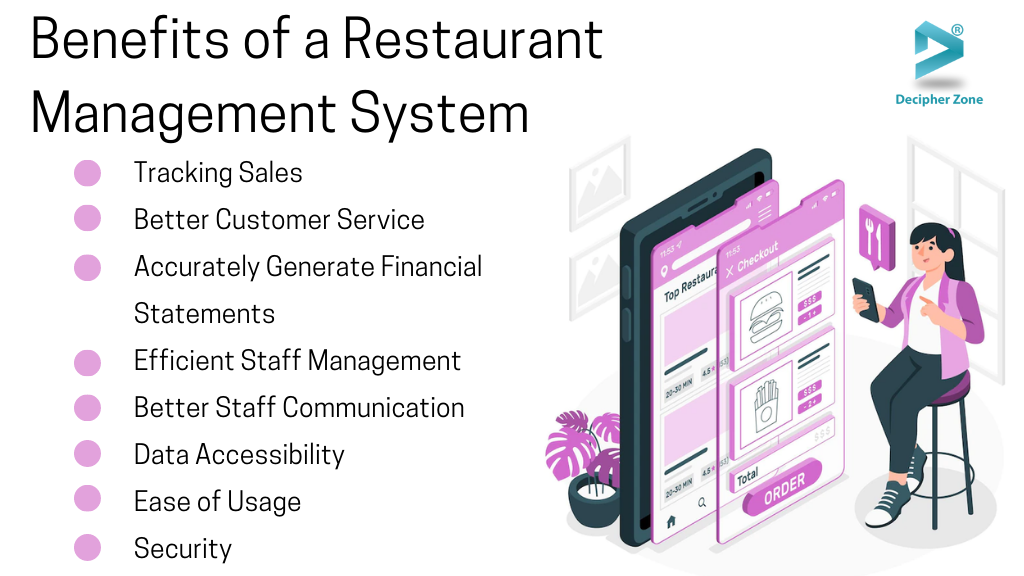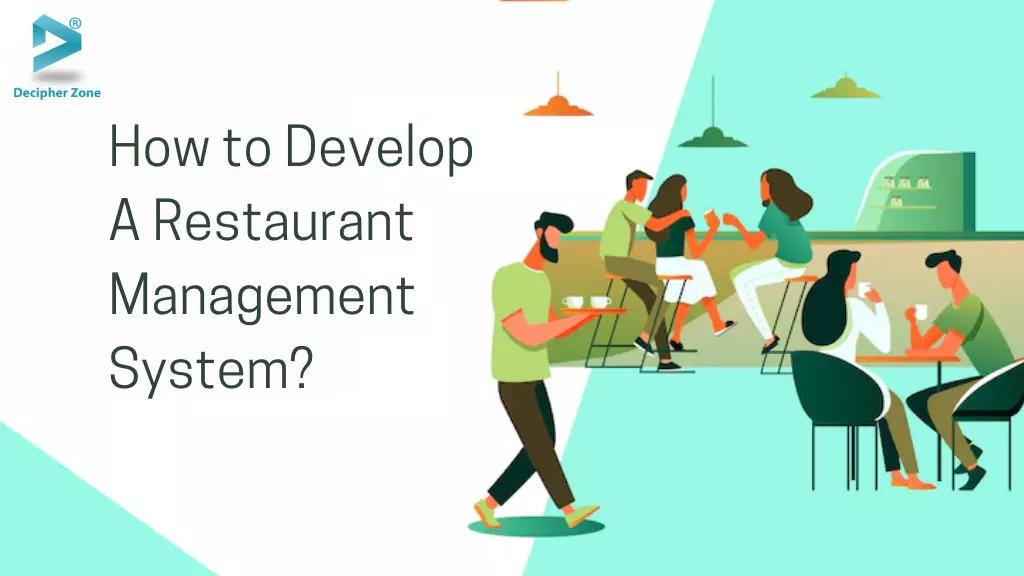Restaurants are undergoing rapid change. Without any prior experience or assistance, running a restaurant can be a real challenge. There are long-term and short-term problems that you will encounter. Restaurants are gradually discontinuing things that were common a few years ago and replacing them with more efficient and quicker methods of operating. Innovation and technology have revolutionized restaurant operations, and by using restaurant management software correctly, restaurants can ensure their success.
In addition to managing every aspect of your restaurant operations, the restaurant management ecosystem allows you to focus on your cuisine and service to your customers. As a restaurant worker, you might know the difficulties that can come your way while handling different problems manually and even some of the points of sales software might seem of no use.
With a focus to improve the efficiency and performance of the staff, most restaurants have already developed a restaurant management system. Additionally, as per the reports from Grand View Research, the market for restaurant management software was valued at $4.08 billion in 2021 and is anticipated to grow between 2022 and 2030 at a compound annual growth rate of 15.8%.
Representatives of restaurants majorly go for management software to achieve different goals, including order or inventory management, payments and analytics. Using these management tools helps in simplifying and streamlining onboarding and workflow controlling processes.
Still, some of the newbies in the restaurant industry often find themselves confused when it comes to developing a restaurant management system. That’s why in this blog we will start from the basics and move on to the cost and development requirements for the restaurant management system (RMS).
So, let’s get started!
What is a Restaurant Management System?
On a basic level, a restaurant management system is a software application that consists of all the marketing and operational elements that will be helpful to running your restaurant effectively. Whether it’s order management, payment processing, reconciliation or day-to-day operations, a restaurant management system will assist you in handling all the processes with ease.
Read: How to develop a Multi-Vendor Food Delivery System
RMS is a collective term used to describe any software application that helps in improving food business operations. It can be used by cafes, bars, bakeries, kitchens, food trucks, and restaurants (obviously). Restaurant Management Software combines everything a restaurant needs to run smoothly, from point of sale systems to inventory management to marketing to online presence building.
An integrated restaurant management system, or RMS, handles all the functions and activities of a restaurant including generating invoices, managing orders, booking tables, etc.
What are the Benefits of a Restaurant Management System?
Some of the advantages that using a Restaurant Management System can offer your business include:

-
Tracking Sales
All the transactions that take place around the business hours of a restaurant are captured by the restaurant management system making all your sales data accurate and providing you with the real picture of operations performed. Moreover, sales data can be divided into different categories which will make it easier to rank best selling items, customer names, and payment methods.
-
Better Customer Service
Most restaurant management systems are designed with customer relationship management features that will record customer details like name, contact information, feedback, and payment transactions. Having a precise understanding of customers’ likes and dislikes, you can easily offer a satisfactory experience to them.
Read: Top 15 Web App Development Ideas To Inspire You in 2022
You can also create mailing lists and run targeted promotional campaigns based on their past orders to make them loyal customers of your restaurant. Also, adding features like online payment and table reservations can make the process of transacting with your business even more convenient for the customers.
-
Accurately Generate Financial Statements
With digital storage of data, chances of manual errors are reduced. Now each transaction is recorded with a timestamp and information like sold items, the service provider name and the name of the one who performed the transaction. This maintains the integrity of the financial records to generate accurate financial reports with just a few clicks.
Read: How to Develop a Logistics Management System
-
Efficient Staff Management
A restaurant management system that includes an employee scheduler will allow you to assign enough staff throughout busy hours while reducing idle time. By combining sales figures with staff schedules, you can match product availability and ensure that your resources are not misleading or underutilized.
-
Better Staff Communication
If the restaurant management system is incorporated into a handheld device, the staff is allowed to communicate efficiently with each other. For example, when a waiter takes orders using a handheld device, that data is automatically transmitted to the cashier and kitchen, which makes the billing accurate and increases the speed of food preparation simultaneously. That also minimizes the waiting time for the customer and improves work efficiency.
Read: Best Practices For a Secure App Development Process
-
Data Accessibility
Cloud-hosted restaurant management software lets you access your data from a web browser and access the system. On the go, you can get real-time sales information and track employee performance. The restaurant can therefore be managed while you are away from the restaurant premises. The ability to access data remotely is also helpful when presenting to clients or investors. This will allow you to show off updated reports about your business.
-
Ease of Usage
The interface of the restaurant management system is designed to make it simple to use so that even a new employee can interact with it effectively.
Read: Top 11 Popular Database For Web App Development
-
Security
Restaurant owners fail to realize that the best way to prevent such losses is to implement a restaurant management system with a comprehensive set of security tools.
Must-Have Restaurant Management System Features
Now that we have a basic understanding of the restaurant management system and its benefits, it’s time to know what are some of the features to consider when building an RMS.
-
Sales and Tax Tracking
In order to make informed business decisions, your RMS should track all sales data, consisting of the busiest selling time, top menu items, top-performing team members and profits. Detailed tax records should also be provided in your software.
Read: Web Application Development Process
-
Order Management
The RMS should make it simple for your restaurant staff to manage tables, reservations, menu items and checks. Controlling voids, refunds, and comps, as well as viewing order statuses, should be possible for you and your managers. The restaurant management system should enable the pre-authorization of credit cards to open tabs if you run a bar.
-
Inventory Management
With the inventory management in the restaurant management system, you can know the total volume of products that you have in store. It will also help you to determine when you have to contact your vendors for the limited stocks.
-
Reporting and Customer Data
With an RMS that tracks and filters all the information about customers and sales of the restaurant, you will be able to make informed marketing decisions that will help your business grow to the next level.
Read: What is Custom Software Development
-
Gift Coupons and Referral Programs
You can ask your developers to add a section where referral rewards and gift coupons for the customer can be found. It can be used as a marketing tool for promotions and will return loyalty from customers.
-
Interactive Menu
The most crucial part of the restaurant management web app is the menu. It should be interactive enough that both customers and employees can search for the food item from the corresponding category with ease. Another feature that can be added for making the menu interactive is the one-click ordering feature if they want to book something from past orders.
-
Online Ordering and Pre-ordering
By adding the online on-time or pre-ordering feature, you can help customers in deciding the delivery time for their order. It will save a lot of time for customers if they are ordering for a party or meeting. This will make them recommend your restaurant to others as well.
Read: How Much Does it Cost to Develop a Crypto Wallet App
-
Table Reservations
Another feature that can be added to the restaurant management system is table reservations. Traditionally, one can book table reservations through phone calls, forms, etc. The convenient way to do so is to add the table reservation feature which will save time for the users. It helps customers to select the desired table, place an order in advance, and even cancel or edit the booking details as per their requirements.
-
Online Payments Processing
While developing a restaurant management system, there should be a feature to pay online using different payment methods like PayPal, Debit Card or Credit Card). If a group of people wants to book different dishes from the restaurant where every person is going to pay for themselves, breaking up the total can be inconvenient between the meals. So, the app should also include a feature to split the amount for the order.
How to Make a Restaurant Management System?
To put it simply, for developing a restaurant management system, you need to follow the given steps:
-
Do market research and track down the problems you want to solve,
-
Build a business plan,
-
Select a trustworthy company to outsource,
-
Visualize your UI/UX design,
-
Research on data security and protection tools for your web app,
-
Let developers work on the backend and frontend of the web app,
-
Test the web app functionality,
-
Launch your web app and promote it through digital marketing.
Cost to Develop a Restaurant Management System
Finally, the most important part is how much it would cost to build a restaurant management system for your business. Although the cost of developing a web app for your restaurant completely depends on the requirements you have and the technology you are going to use for its development. But to give you a rough idea, it can range anywhere from $30,000 to $70,000 to develop a fully-customized restaurant management system.
To share your idea and get an exact quote, get in touch with our experts who will guide you throughout the process.

